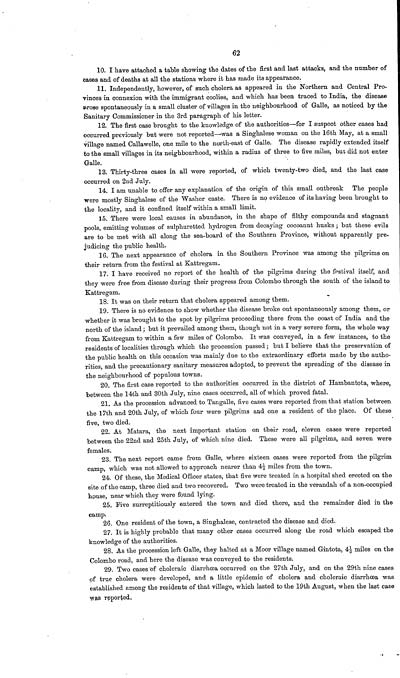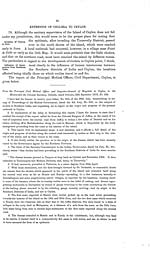Medicine - Disease > Cholera in southern India
(86) Page 62
Download files
Individual page:
Thumbnail gallery: Grid view | List view

62
10. I have attached a table showing the dates of the first and last attacks, and the number of
cases and of deaths at all the stations where it has made its appearance.
11. Independently, however, of such cholera as appeared in the Northern and Central Pro-
vinces in connexion with the immigrant coolies, and which has been traced to India, the disease
arose spontaneously in a small cluster of villages in the neighbourhood of Galle, as noticed by the
Sanitary Commissioner in the 3rd paragraph of his letter.
12. The first case brought to the knowledge of the authorities-for I suspect other cases had
occurred previously but were not reported-was a Singhalese woman on the 16th May, at a small
village named Callawelle, one mile to the north-east of Galle. The disease rapidly extended itself
to the small villages in its neighbourhood, within a radius of three to five miles, but did not enter
Galle.
13. Thirty-three cases in all were reported, of which twenty-two died, and the last case
occurred on 2nd July.
14. I am unable to offer any explanation of the origin of this small outbreak The people
were mostly Singhalese of the Washer caste. There is no evidence of its having been brought to
the locality, and it confined itself within a small limit.
15. There were local causes in abundance, in the shape of filthy compounds and stagnant
pools, emitting volumes of sulphuretted hydrogen from decaying cocoanut husks; but these evils
are to be met with all along the sea-board of the Southern Province, without apparently pre-
judicing the public health.
16. The next appearance of cholera in the Southern Province was among the pilgrims on
their return from the festival at Kattregam.
17. I have received no report of the health of the pilgrims during the festival itself, and
they were free from disease during their progress from Colombo through the south of the island to
Kattregam.
18. It was on their return that cholera appeared among them.
19.. There is no evidence to show whether the disease broke out spontaneously among them, or
whether it was brought to the spot by pilgrims proceeding there from the coast of India and the
north of the island; but it prevailed among them, though not in a very severe form, the whole way
from Kattregam to within a few miles of Colombo. It was conveyed, in a few instances, to the
residents of localities through which the procession passed; but I believe that the preservation of
the public health on this occasion was mainly due to the extraordinary efforts made by the autho-
rities, and the precautionary sanitary measures adopted, to prevent the spreading of the disease in
the neighbourhood of populous towns.
20. The first case reported to the authorities occurred in the district of Hambantota, where,
between the 14th and 30th July, nine cases occurred, all of which proved fatal.
21. As the procession advanced to Tangalle, five cases were reported from that station between
the 17th and 20th July, of which four were pilgrims and one a resident of the place. Of these
five, two died.
22. At Matara, the next important station on their road, eleven cases were reported
between the 22nd and 25th July, of which nine died. These were all pilgrims, and seven were
females.
23. The next report came from Galle, where sixteen cases were reported from the pilgrim
camp, which was not allowed to approach nearer than 41/2 miles from the town.
24. Of these, the Medical Officer states, that five were treated in a hospital shed erected on the
site of the camp, three died and two recovered. Two were treated in the verandah of a non-occupied
house, near which they were found lying.
25. Five surreptitiously entered the town and died there, and the remainder died in the
camp.
26. One resident of the town, a Singhalese, contracted the disease and died.
27. It is highly probable that many other cases occurred along the road which escaped the
knowledge of the authorities.
28. As the procession left Galle, they halted at a Moor village named Gintota, 41/2 miles on the
Colombo road, and here the disease was conveyed to the residents.
29. Two cases of choleraic diarrha occurred on the 27th July, and on the 29th nine cases
of true cholera were developed, and a little epidemic of cholera and choleraic diarrha was
established among the residents of that village, which lasted to the 19th August, when the last case
was reported.
10. I have attached a table showing the dates of the first and last attacks, and the number of
cases and of deaths at all the stations where it has made its appearance.
11. Independently, however, of such cholera as appeared in the Northern and Central Pro-
vinces in connexion with the immigrant coolies, and which has been traced to India, the disease
arose spontaneously in a small cluster of villages in the neighbourhood of Galle, as noticed by the
Sanitary Commissioner in the 3rd paragraph of his letter.
12. The first case brought to the knowledge of the authorities-for I suspect other cases had
occurred previously but were not reported-was a Singhalese woman on the 16th May, at a small
village named Callawelle, one mile to the north-east of Galle. The disease rapidly extended itself
to the small villages in its neighbourhood, within a radius of three to five miles, but did not enter
Galle.
13. Thirty-three cases in all were reported, of which twenty-two died, and the last case
occurred on 2nd July.
14. I am unable to offer any explanation of the origin of this small outbreak The people
were mostly Singhalese of the Washer caste. There is no evidence of its having been brought to
the locality, and it confined itself within a small limit.
15. There were local causes in abundance, in the shape of filthy compounds and stagnant
pools, emitting volumes of sulphuretted hydrogen from decaying cocoanut husks; but these evils
are to be met with all along the sea-board of the Southern Province, without apparently pre-
judicing the public health.
16. The next appearance of cholera in the Southern Province was among the pilgrims on
their return from the festival at Kattregam.
17. I have received no report of the health of the pilgrims during the festival itself, and
they were free from disease during their progress from Colombo through the south of the island to
Kattregam.
18. It was on their return that cholera appeared among them.
19.. There is no evidence to show whether the disease broke out spontaneously among them, or
whether it was brought to the spot by pilgrims proceeding there from the coast of India and the
north of the island; but it prevailed among them, though not in a very severe form, the whole way
from Kattregam to within a few miles of Colombo. It was conveyed, in a few instances, to the
residents of localities through which the procession passed; but I believe that the preservation of
the public health on this occasion was mainly due to the extraordinary efforts made by the autho-
rities, and the precautionary sanitary measures adopted, to prevent the spreading of the disease in
the neighbourhood of populous towns.
20. The first case reported to the authorities occurred in the district of Hambantota, where,
between the 14th and 30th July, nine cases occurred, all of which proved fatal.
21. As the procession advanced to Tangalle, five cases were reported from that station between
the 17th and 20th July, of which four were pilgrims and one a resident of the place. Of these
five, two died.
22. At Matara, the next important station on their road, eleven cases were reported
between the 22nd and 25th July, of which nine died. These were all pilgrims, and seven were
females.
23. The next report came from Galle, where sixteen cases were reported from the pilgrim
camp, which was not allowed to approach nearer than 41/2 miles from the town.
24. Of these, the Medical Officer states, that five were treated in a hospital shed erected on the
site of the camp, three died and two recovered. Two were treated in the verandah of a non-occupied
house, near which they were found lying.
25. Five surreptitiously entered the town and died there, and the remainder died in the
camp.
26. One resident of the town, a Singhalese, contracted the disease and died.
27. It is highly probable that many other cases occurred along the road which escaped the
knowledge of the authorities.
28. As the procession left Galle, they halted at a Moor village named Gintota, 41/2 miles on the
Colombo road, and here the disease was conveyed to the residents.
29. Two cases of choleraic diarrha occurred on the 27th July, and on the 29th nine cases
of true cholera were developed, and a little epidemic of cholera and choleraic diarrha was
established among the residents of that village, which lasted to the 19th August, when the last case
was reported.
Set display mode to: Large image | Zoom image | Transcription
Images and transcriptions on this page, including medium image downloads, may be used under the Creative Commons Attribution 4.0 International Licence unless otherwise stated. ![]()
| India Papers > Medicine - Disease > Cholera in southern India > (86) Page 62 |
|---|
| Permanent URL | https://digital.nls.uk/74534332 |
|---|




